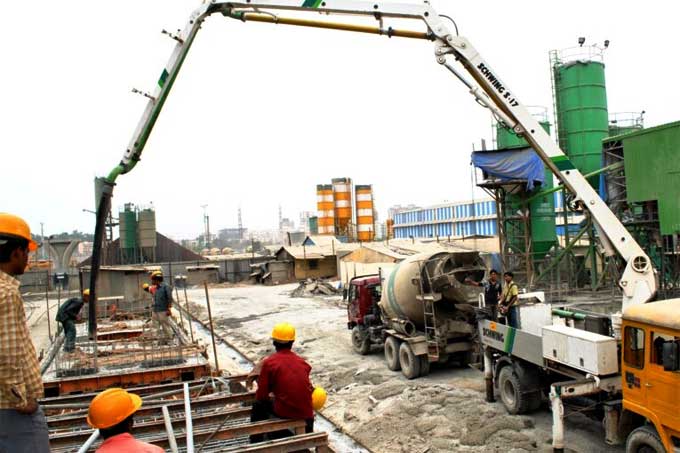
Concrete Pump: Types, Advantages and Disadvantages

Concrete pumps can convey continuous concrete to pouring construction sites either horizontally or vertically through pipes. It pumps liquid concrete to the job site using a motor or diesel engine. In addition to helping place concrete quickly, concrete pumps are used in inaccessible areas.
Types of Concrete Pumps
Boom or Truck Mounted Concrete Pump
Concrete pumps of this type are suitable for roads and highways, as they're larger.
These machines are often mounted on trucks or semi-trailers and come equipped with a remotely controlled automatic robotic arm, known as a boom, to place concrete as per requirement. In addition, to navigate obstacles while moving, a boom pump mounted on a truck is also called this.
It is convenient to use these pumps at large construction sites and places, which limits space around the pouring area. The presence of a multipurpose robotic arm in these pumps enables them to save significant labor costs.
Squeeze Concrete Pump
Pumps like these are small, portable punching pumps. Concrete is fed from the collecting hopper into a flexible pipe and pumped under approximately 0.08 N/mm2 vacuum pressures into the pumping chamber.
Vacuums ensure cylinder-shaped pipes squeezes by rotating rollers, which ensures concrete flows continuously. Those two rotating rollers, mounted on a globally driven system, squeeze the concrete into the delivery pipe. Although big companies might buy them, owners of small and medium businesses prefer using concrete pumps.
Specialized Usage Concrete Pump
They are used in places such as mines and tunnels that require specialized pumps. Due to their high cost and intricate mechanism, these pumps infrequently use, typically mounted on a skid or a rail.
Stationary Concrete Pump
That is a smaller concrete pump used for smaller jobs such as preparing ground slabs and sidewalks. Concrete pumps mount on a trailer or are attached to a truck, but their outlet attaches to flexible rubber or steel hoses.
It has less mobility than a boom pump, but it can join any extension hose to reach anywhere the concrete needs to keep. Due to their faster concrete pumping rates, they better suit smaller projects.
Direct Acting Concrete Pump
Pumps with semi-rotary valves, this type operates with a horizontal piston and direct-acting piston. Pumps of this type operate simply by suction and gravity. The concrete is pumping in by reciprocating the motion of the horizontal actuator, which acts as a piston.
In the pumping cylinder, 0.08 N/mm2 of suction pressure develops by the semi-rotary valves alternately open and closed.
The Flow of concrete through the suction pipe should be free of obstructions due to large aggregates, and possible blockages should be avoided.
Concrete aggregate must have a diameter three times that of the suction pipe, and the suction pipe's width controls the overall size.
Pros of Concrete Pump
A. Especially good at placing concrete at high altitudes or at far-off locations on a site.
B. Pouring can be done in different locations.
C. Concrete is needed at various locations each day in small quantities for certain projects. For example, bridges or dams.
D. Dependence on laborers is very low.
E. Conveyance of concrete from the mixer to the pouring point as quickly as possible.
F. Whenever other concrete transport mechanisms such as cranes, trolleys, etc. are not feasible.
G. Unlike other methods of transporting concrete such as cranes or trolleys, the pump does not depend on light to function safely.
H. During transportation, prevent moisture loss.
I. Using the pump can reduce the rental costs for machinery because it can be used at many different sites.
J. Concrete placed across a channel makes use of this method; in other situations, transportation methods and settings are too expensive.
K. There are no limits to the number of placements.
L. Depending on how much concrete is needed, it can be designed accordingly.
Cons of Concrete Pump
A. There will be a higher overall price than for other pumps.
B. The budget for constructing a private house is much smaller than for constructing a commercial structure, so commercial buildings are best suited for construction.
Conclusion
Concrete pumps, also known as boom concrete pumps, are machines that pump liquid concrete, and they use a boom for holding the concrete in place correctly.
The coagulation process is utilized in a wide range of applications such as high-rise construction, municipal construction, electric power, transportation, and other industrial buildings that require high quality, strict performance requirements, and long conveying distances. Building on narrow sites is especially challenging.

Imaage Courtesy: concretecivil.com

